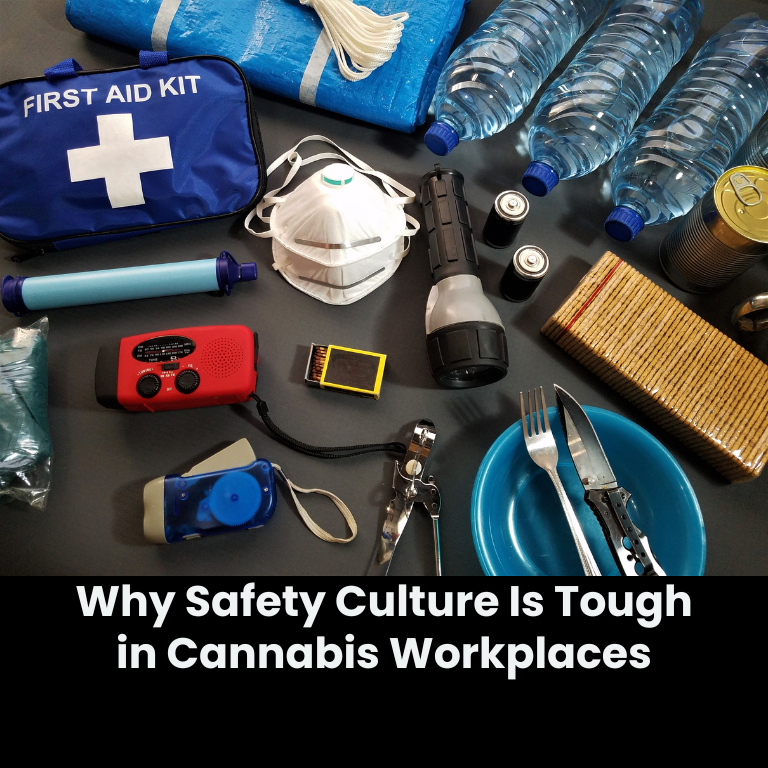Building a Safety Culture in the Cannabis Industry
As the legal cannabis industry matures, it’s facing an increasingly important—but often overlooked—challenge: workplace safety. While much of the public conversation centers on legalization, compliance, and market growth, industry professionals know that real sustainability also depends on cultivating a strong safety-first culture across cultivation, manufacturing, and retail operations.
With expanding operations, complex extraction processes, and high employee turnover in some sectors, the cannabis industry is learning that safety can’t be treated as an afterthought. Instead, it must be embedded into every facet of business operations.
The Need for a Proactive Approach
Unlike more established industries like pharmaceuticals or agriculture, cannabis operators often lack the deep-rooted regulatory frameworks and standardized safety protocols that other sectors rely on. This creates a situation where businesses are sometimes left to develop their own best practices, often without adequate guidance.
Cannabis cultivation and processing environments introduce a wide range of potential hazards:
-
Exposure to chemicals like pesticides and solvents
-
Repetitive motion injuries in trimming and packaging
-
Fire and explosion risks in extraction facilities
-
Airborne contaminants such as mold spores or dust
-
Slips, trips, and falls in greenhouse or warehouse settings
In the absence of federal oversight from agencies like OSHA—due to cannabis’s federal Schedule I status—state-level guidelines vary widely, leaving a patchwork of standards that can make consistency difficult, especially for multistate operators.
What Is a Safety Culture?
A safety culture refers to the shared beliefs, practices, and attitudes that exist within a workplace regarding safety. In strong safety cultures, safety is not just a checklist—it’s a core value that influences every action and decision.
Key elements of a successful safety culture include:
-
Leadership commitment to safety
-
Employee involvement and empowerment
-
Open communication about risks and incidents
-
Continuous training and education
-
Accountability at all levels
A robust safety culture doesn’t just reduce accidents; it enhances employee morale, improves retention, and ultimately supports higher-quality operations.
Leadership: The Foundation of Safety
In any industry, safety begins at the top. In cannabis, where many businesses are still in startup mode, leaders may be juggling compliance, expansion, and financing—leaving little time for formal safety programs.
But companies that invest in safety leadership see clear returns. Executives and managers must model safe behaviors, support funding for safety initiatives, and ensure that safety is integrated into strategic planning—not just operations.
When leadership takes safety seriously, employees do too.
Training and Education
A major barrier to building safety culture in cannabis is the lack of industry-specific training resources. While generic workplace safety training is valuable, cannabis workplaces involve unique conditions that require tailored approaches.
For instance:
-
Trimmers and packagers often work long hours in repetitive positions, requiring ergonomic training.
-
Extraction technicians deal with flammable materials and must understand both chemical safety and fire prevention.
-
Cultivators may use pesticides and fertilizers that require special handling and Personal Protective Equipment (PPE).
Regular training sessions, safety briefings, and certifications are essential. Just as important, though, is making safety part of the onboarding process so that every new hire understands its priority from day one.
Empowering Employees
Creating a safety-first culture isn’t just about mandates from above. It also requires empowering employees to speak up and take ownership of safety practices.
Encouraging workers to report hazards, suggest improvements, and even stop work if something seems unsafe builds a culture of trust and accountability. Companies can support this by creating anonymous reporting tools, holding regular safety meetings, and offering incentives for proactive behavior.
Peer-to-peer safety programs, where workers train or monitor each other, can be especially effective in reinforcing standards on the ground.
Incident Reporting and Continuous Improvement
Mistakes and accidents are inevitable—but how a company responds to them determines whether it improves or stays stagnant. A safety-first cannabis company must establish clear, easy-to-follow procedures for incident reporting and investigation.
Every incident, no matter how small, should trigger a root cause analysis, followed by policy updates or process improvements. Transparent communication about lessons learned helps reinforce the idea that safety is an evolving priority—not a fixed policy.
Data collection is also key. Tracking injury rates, near misses, and equipment failures allows businesses to spot patterns and prevent future issues.
Regulatory Compliance and Beyond
While OSHA does have authority over cannabis businesses in legal states, enforcement is inconsistent, and many smaller companies are unaware of their obligations. Where applicable, businesses should follow OSHA standards as best practice, even in areas not yet directly enforced.
States like California, Colorado, and Oregon have published cannabis-specific safety guidelines, particularly for extraction facilities. However, many safety experts recommend that companies go beyond minimum compliance, especially in areas like chemical exposure, ventilation, and PPE.
Developing a written Injury and Illness Prevention Plan (IIPP), conducting regular safety audits, and engaging third-party safety consultants are common steps for companies looking to raise their standards.
Safety in Retail Environments
Although much attention is placed on cultivation and manufacturing, cannabis retail operations also require a thoughtful approach to safety. Security protocols, cash handling procedures, and customer interaction guidelines all intersect with employee well-being.
Moreover, many dispensaries operate in urban areas where employees may face risks related to robbery or aggressive customers. Investing in security training, surveillance infrastructure, and clear de-escalation protocols is vital for protecting both staff and consumers.
Retail employees should also be trained in ergonomics, especially when dealing with long hours on their feet or repetitive sales transactions.
The ROI of Safety
Though safety programs require upfront investment, the return on investment is clear. Fewer accidents mean:
-
Lower workers’ compensation claims
-
Less downtime and lost productivity
-
Higher employee satisfaction and retention
-
Reduced risk of lawsuits and reputational damage
In competitive markets, companies known for treating their employees well often have a recruiting advantage. Safety is a major part of that reputation.
Raising Industry Standards
As cannabis legalization spreads and the industry grows, workplace safety will need to evolve from an afterthought to a strategic pillar. Companies that proactively build safety culture now will be better positioned to compete, grow, and retain talent in the years to come.
Trade associations, regulators, and educational institutions can help by offering industry-specific safety certifications, developing training curricula, and standardizing best practices. But ultimately, it’s up to each company to make safety a core value not just a line item.















